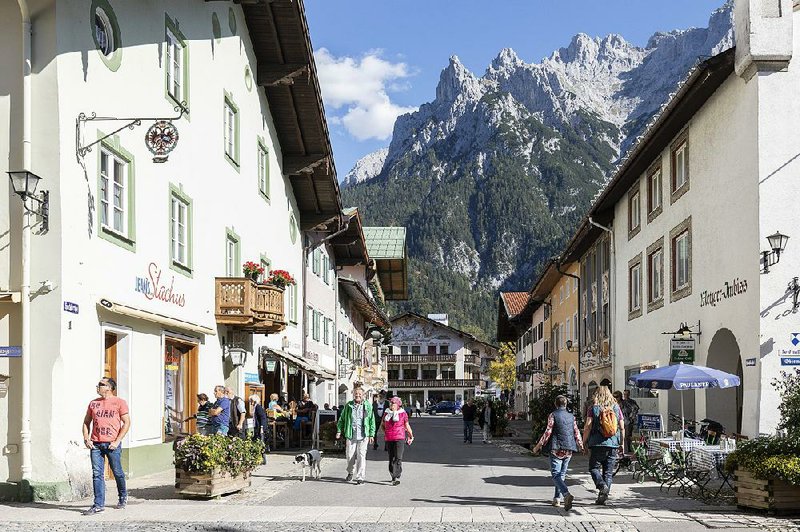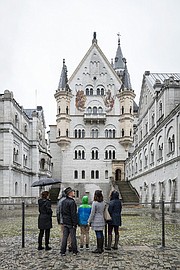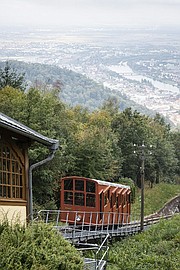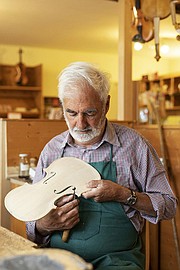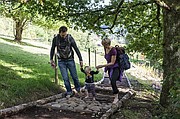Certain trips acquire an almost mythical quality over time: You leave home at the right moment and return just as it passes. You have friends to visit along your route, and all of them are delighted to put you up. You rent the right car, pack the right books, eat remarkably well and make your own discoveries, all roughly within your budget. Glowing memories ensue.
For me, it was southern Germany, circa 2003, and it was a solo vacation: route devised according to my whims alone; tiny car stocked with audiobooks entirely of my choosing; and a freelance assignment to help finance the thing. I flew into Frankfurt, where I visited college friends, and continued to Heidelberg. Then it was all work in Baden-Baden, where I had been asked to compare the town's famed Old World spa treatments with the latest high-tech spas in New York for a women's magazine.
For nearly three weeks, I meandered through the Black Forest, across the Alpenstrasse, where small woodland creatures seemed to frolic beside me Snow White-style, in the early October frost, into Munich and then up north through a landscape speckled with Germany's famed castles and medieval cities (known as the Romantic Road) back to Frankfurt.
There was only one thing missing: children. The toyshops of Heidelberg, their wares clearly cobbled together by wood sprites with tiny hammers, begged for a child's awed gasps. The Black Forest, with its wooded peaks, signature cake and half-timbered houses, wasn't quite Grimm enough without them. Cuckoo clocks are not for grown-ups. The Deutsches Museum in Munich needed kids running around its trains; the night watchman's tour of Rothenburg was intended to spook.
These things were best appreciated by a family, and I didn't have one.
Fifteen years later, I do, and the plan was to replicate, as closely as possible, my original itinerary together, a family of five. Would the magic hold up and perhaps acquire extra fairy dust in the company of three medium-size children? Was the timing right, or were we too late?
Now 9, 11 and 13, my children had graduated from wooden playthings, and left behind earlier days of reading Grimm. They'd moved on to Greek myths and J.R.R. Tolkien, Dungeons & Dragons and dystopian fiction, although the source material was clearly the same.
Traveling with one or two kids is relatively straightforward: You can rent pretty much any size car. You can squeeze into a single room. Not so when you've overdone it with three or more.
Unless your children have the magical combination of age, gender and disposition to sleep peacefully in the same bed (hats off), you need a room with four beds, or better yet, a room with one bed and another with three.
You also need a minivan. Not a stylish European minivan. No, you need a big, dumb American version -- and do not confuse that with an SUV, which has neither the legroom for five nor the trunk capacity for five suitcases. Car rental companies do not generally get into these subtleties.
We set off to Heidelberg on a series of German autobahns, squeezed into what felt like a VW Beetle.
We kept our rides under two hours. Remaining within two regions, Baden-Wurttemberg and Bavaria, we traveled from Heidelberg to Baden-Baden, through the Black Forest, down to the Bodensee and into Bavaria, upward to Munich and northward on the Romantic Road back to Frankfurt.
Our hotels began in jet-lag-friendly luxury, before downshifting to more modest, but still spacious, lodgings and a three-day Airbnb in Munich, with a strategic happy ending at a castle stay outside Rothenburg ob der Tauber.
Once in Heidelberg, we settled into the Die Hirschgasse hotel, just across the Neckar River from the city's Fodor's-friendly Altstadt (Old Town). We made our way down the main commercial stretch, infusing ourselves with gelato and gummy candy at regular intervals while dodging a swarm of bees that had apocalyptically descended on the town (fairy-tale reference point: "The Queen Bee," Brothers Grimm, Tale 62).
We then set out for the local postcard attraction, the ruins of Schloss Heidelberg, best reached by a funicular tram (sit at the front of the head car on the way down for that vertiginous plunge kids can't seem to get enough of). The castle is defunct; its trimmings and furniture, long gone. But a few key historical items remained in the interior. Our favorite was the "Big Barrel," which we imagined inebriating many a medieval castle dweller in its day, discovered Goldilocks-fashion only after following signs that led first to a deceptively large "small" barrel, then to a medium one (immense). It was hard not to imagine a giant of yore guzzling draft from its spout.
Darkness truly descended in Triberg, a touristy slice of the Black Forest set on a hill under Germany's highest waterfall. Here, I had promised my children a visit to the Cuckoo Clock Museum. I had such fond memories of the place. The museum's main room was cavernous. Inside, Geppetto-style, was clock after chirping clock, each more wondrously intricate than the last.
But where was the museum? We visited many kitschy cuckoo clock stores, all apparently called "House of 1,000 Clocks," and a very modern German Clock Museum, which had one singular and magnificent cuckoo specimen but was otherwise a standard glass-displayed history of time-telling accompanied by all-German labels. We went to the Black Forest Museum, which had an excellent collection of "orchestriums," mechanical machines that replicated the sound of a full orchestra. Yet the magical museum of my memory was not to be found.
And so we went to the park. Two of them. In recent decades, "barefoot parks," public spaces specifically groomed to accommodate earthy types without their Birkenstocks, have sprung up around Europe. For a small fee, visitors are provided lockers for their shoes, before setting off on a path designed to heighten one's attention to the senses, from the painful spike of walking across wood chips or on gravel, to the squishiness of traipsing through mud puddles. Along the way, visitors are encouraged to touch, smell and explore the outdoors and meditate in the shade.
Our chosen destination, the Park of the Senses, outside the town of Gutach, felt like a tonic after the touristic onslaught of cuckoo chimes. We headed into the woods. On the far side of one especially sunny stretch was a dark, enclosed chamber; we plunged in through heavy flaps where we made our way along an uneven footpath through twisty corridors.
Our second park was more conventional. Visiting an amusement park, with the exception of Copenhagen's historic Tivoli, has never been on the top of my European to-do list. But how could I deprive my offspring of Europa Park, billed as Europe's second-largest (after a certain American import in Paris) and conveniently situated in the French-German border town of Rust?
Europa Park is like Disneyland stripped of its commercial veneer. Organized nominally by European country, the food and rides reflect each geographic region. Germany naturally covers the most territory, and a lovely section is dedicated to Grimm's Enchanted Forest, where the tales are fairly represented without cuddly bunnies to offset the fright.
A subtler fairy-tale setting was found in Mittenwald, Germany's center for violin-making, with its impeccably preserved pedestrian old town, canals flowing along the cobblestone streets. The exterior walls of its whitewashed buildings are painted Bavarian-style with biblical scenes and imagery depicting the varying trades of the shopkeepers and restaurateurs within. My two cello-playing sons were entranced by visits to the studios of celebrated luthiers Anton Maller, who allowed my trembling older son to play a $10,000 cello, and Anton Sprenger, who gave us an impromptu concert on his own violin.
Then we entered into a story ourselves. Reunited with one of our former German au pairs in Munich, we bounded from museum and palace to platz and shopping arcade throughout the city until, near exhaustion, we happened on a temporary exhibition, "Thrill of Deception," at the Kunsthalle. Inside, a series of rooms showcased the arts of optical illusion, trompe d'oeil and visual trickery from the ancient world to today.
Near the end, like a hidden treasure, we discovered Laurie Anderson and Hsin-Chien Huang's 2017 virtual-reality installation, "Chalkroom."
The viewer, or more accurately, the participant, enters a dark room whose walls are covered with words scrawled in chalk. Wearing a virtual-reality headset with attached remote controls, you're offered various options for exploring the virtual landscape. You can fly, for example, through swirling words or plunge yourself headlong into the text. Phrases rush by, occasionally forming sentences. You are fully immersed in -- and only occasionally in control of -- the narrative.
It's a very contemporary form of storytelling, a technologically enhanced one, a kind of modern magic, a voyage of discovery where you are at once storyteller and reader. We emerged, all of us, flushed with enchantment.
Travel on 12/30/2018
